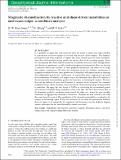Files in this item
Magmatic channelization by reactive and shear-driven instabilities at mid-ocean ridges : a combined analysis
Item metadata
| dc.contributor.author | Rees Jones, D W | |
| dc.contributor.author | Zhang, H | |
| dc.contributor.author | Katz, R F | |
| dc.date.accessioned | 2021-05-07T09:30:01Z | |
| dc.date.available | 2021-05-07T09:30:01Z | |
| dc.date.issued | 2021-07 | |
| dc.identifier | 273686654 | |
| dc.identifier | 2fe1e0f0-8a40-410f-a908-76ace51d81b9 | |
| dc.identifier | 000680830600035 | |
| dc.identifier | 85119400537 | |
| dc.identifier.citation | Rees Jones , D W , Zhang , H & Katz , R F 2021 , ' Magmatic channelization by reactive and shear-driven instabilities at mid-ocean ridges : a combined analysis ' , Geophysical Journal International , vol. 226 , no. 1 , pp. 582–609 . https://doi.org/10.1093/gji/ggab112 | en |
| dc.identifier.issn | 0956-540X | |
| dc.identifier.other | Jisc: 901c4c139e81402d8701f492bd1d7fdb | |
| dc.identifier.other | ORCID: /0000-0001-8698-401X/work/92020388 | |
| dc.identifier.uri | https://hdl.handle.net/10023/23129 | |
| dc.description | D.W.R.J. acknowledges research funding through the NERC Consortium grant NE/M000427/1. The research of R.F.K. leading to these results received funding under the European Union’s Horizon 2020 research and innovation programme, grant agreement number 772255. | en |
| dc.description.abstract | It is generally accepted that melt extraction from the mantle at mid-ocean ridges (MORs) is concentrated in narrow regions of elevated melt fraction called channels. Two feedback mechanisms have been proposed to explain why these channels grow by linear instability: shear flow of the partially molten mantle and reactive flow of the ascending magma. These two mechanisms have been studied extensively, in isolation from each other, through theory and laboratory experiments as well as field and geophysical observations. Here, we develop a consistent theory that accounts for both proposed mechanisms and allows us to weigh their relative contributions. We show that interaction of the two feedback mechanisms is insignificant and that the total linear growth rate of channels is well-approximated by summing their independent growth rates. Furthermore, we explain how their competition is governed by the orientation of channels with respect to gravity and mantle shear. By itself, analysis of the reaction-infiltration instability predicts the formation of tube-shaped channels. We show that with the addition of even a small amount of extension in the horizontal, the combined instability favours tabular channels, consistent with the observed morphology of dunite bodies in ophiolites. We apply the new theory to MORs by calculating the accumulated growth and rotation of channels along streamlines of the solid flow. We show that reactive flow is the dominant instability mechanism deep beneath the ridge axis, where the most unstable orientation of high-porosity channels is subvertical. Channels are then rotated by the solid flow away from the vertical. The contribution of the shear-driven instability is confined to the margins of the melting region. Within the limitations of our study, the shear-driven feedback does not appear to be responsible for significant melt focusing or for the shallowly dipping seismic anisotropy that has been obtained by seismic inversions. | |
| dc.format.extent | 8763752 | |
| dc.language.iso | eng | |
| dc.relation.ispartof | Geophysical Journal International | en |
| dc.subject | Permeability and porosity | en |
| dc.subject | Instability analysis | en |
| dc.subject | Mechanics, theory, and modelling | en |
| dc.subject | Mid-ocean ridge processes | en |
| dc.subject | Rheology: mantle | en |
| dc.subject | GC Oceanography | en |
| dc.subject | QC Physics | en |
| dc.subject | QE Geology | en |
| dc.subject | DAS | en |
| dc.subject.lcc | GC | en |
| dc.subject.lcc | QC | en |
| dc.subject.lcc | QE | en |
| dc.title | Magmatic channelization by reactive and shear-driven instabilities at mid-ocean ridges : a combined analysis | en |
| dc.type | Journal article | en |
| dc.contributor.institution | University of St Andrews. Applied Mathematics | en |
| dc.contributor.institution | University of St Andrews. Statistics | en |
| dc.identifier.doi | https://doi.org/10.1093/gji/ggab112 | |
| dc.description.status | Peer reviewed | en |
This item appears in the following Collection(s)
Items in the St Andrews Research Repository are protected by copyright, with all rights reserved, unless otherwise indicated.

